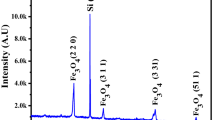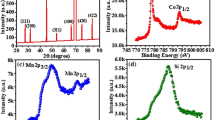Abstract
Purpose of the work is to study a nature of the excess tunnel current in heavily doped silicon p − n junction diodes with lengthy compensation region in the p − n junction. In such the diodes, formation of the system of electron and hole “lakes” and hopping conduction via them is possible at low temperatures. And indeed, electric measurements have shown that this excess tunnel current is characterized by Mott’s temperature dependency. It is reasonable to investigate additionally an influence of magnetic field. Previous studies of the magnetic field influence were limited by the field of 9.4 T and alone temperature of 4.2 K. Now the measurements have been carried out at several temperatures close by the liquid helium temperature and at the magnetic fields up to 13.6 T. It was found that in magnetic fields beyond 9.4 T, the diode magnetoresistance demonstrates transition to field dependency predicted theoretically for variable range hopping conduction of Mott’s type via impurity centers. Thus the excess tunnel current in the diode has character of hopping conduction via impurity centers, irrespective of whether the system of electron and hole “lakes” is generated in compensation region of the p − n junction or not.
Similar content being viewed by others
References
Borblik VL, Shwarts YuM, Shwarts MM, Fonkich AM (2010) Concerning the nature of relaxation oscillations in silicon diodes in the cryogenic temperature region. Cryogenics 50:417–420
Szmyrka-Grzebyk A, Lipinski L (1993) Low temperature current-voltage characteristics of silicon diodes used as thermometers. Cryogenics 33:222–225
(2004) Temperature measurement and control, Product Catalog. Published by Lake Shore Cryotronics, Inc.
Shwarts YuM, Borblik VL, Kulish NR, Sokolov VN, Shwarts MM, Venger EF (1999) Silicon diode temperature sensor without a kink of the response curve in cryogenic temperature region. Sens Actuators 76:107–111
Borblik VL, Shwarts YuM, Shwarts MM (2005) Revealing the hopping mechanism of conduction in heavily doped silicon diodes. Semicond Phys Quantum Electron Optoelectron 8:41–44
Borblik VL, Shwarts YuM, Shwarts MM (2007) Manifestation of disorder effects in excess tunnel current of heavily doped silicon diodes. Bull Russ Acad Sci: Phys 71:1073–1075
Sze SM (1981) Physics of semiconductor devices, 2nd edn. Wiley, New York
Del Alamo JA, Swanson RM (1986) Forward-bias tunneling: a limitation to bipolar device scaling. IEEE Electron Device Lett 7:629–631
Shklovskii BI (1973) Hopping conduction of heavily doped semiconductors. Sov Phys-Semicond 7:77–83
Borblik VL, Rudnev IA, Shwarts YuM, Shwarts MM (2010) Negative magnetoresistance of heavily doped silicon p −n junction. Semicond Phys Quantum Electron Optoelectron 14:88–90
Nguen VL, Spivak BZ, Shklovskii BI (1985) Aaronov-Bohm oscillations with normal and superconducting flux quanta in hopping conductivity. JETP Lett 41:42–45
Nguen VL, Spivak BZ, Shklovskii BI (1985) Tunnel hopping in disordered systems. Sov Phys-JETP 62:1021–1029
Sivan U, Entin-Wohlman O, Imry Y (1988) Orbital magnetoconductance in the variable-range-hopping regime. Phys Rev Lett 60:1566–1569
Entin-Wohlman O, Imry Y, Sivan U (1989) Orbital magnetoconductance in the variable-range-hopping regime. Phys Rev B 40:8342–8348
Shkovskii BI, Efros AL (1984) Electronic properties of doped semiconductors. Springer, Berlin
Dai P, Zhang Y, Sarachik PM (1991) Critical conductivity exponent for Si:B. Phys Rev Lett 66:1914–1917
Mott N, Davis E (1979) Electronic processes in non-crystalline materials. Oxford University, Oxford
Ionov AN, Rentzsch R, Shlimak I (1996) Role of electron “lakes” in the negative magnetoresistance effect in the region of Mott hopping conductivity. JETP Lett 63:199–203
Dai P, Friedman JR, Sarachik MP (1993) Hopping conduction in doped silicon: the apparent absence of quantum interference. Phys Rev B 48:4875–4878
Rivas C, Lake R, Frensley WR, Klimeck G, Thompson PE, Hobart KD, Rommel SL, Berger PR (2003) Full band modeling of the excess current in a delta-doped silicon tunnel diode. J Appl Phys 94:5005–5013
Author information
Authors and Affiliations
Corresponding author
Rights and permissions
About this article
Cite this article
Borblik, V.L., Shwarts, Y.M., Shwarts, M.M. et al. A Study on the Hopping Nature of an Excess Tunnel Current in Heavily Doped Silicon p − n Junction Diodes at Cryogenic Temperatures. Silicon 11, 1011–1015 (2019). https://doi.org/10.1007/s12633-018-9923-z
Received:
Accepted:
Published:
Issue Date:
DOI: https://doi.org/10.1007/s12633-018-9923-z




